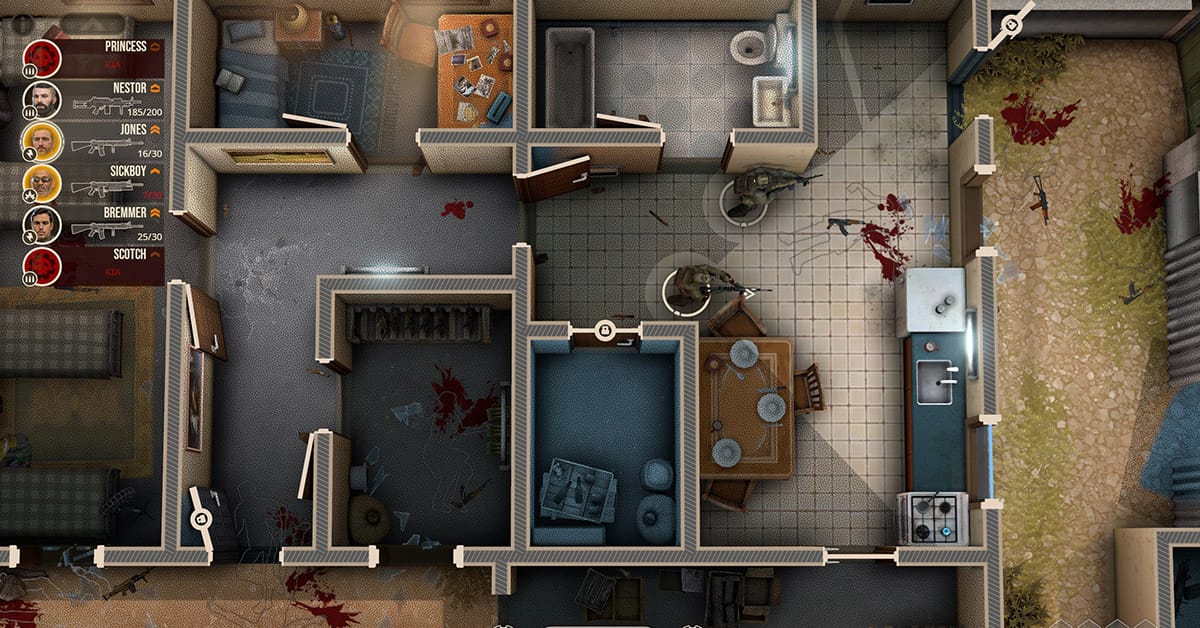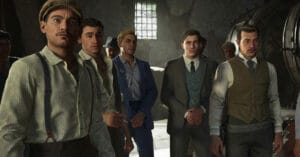*A review code for Doorkickers 2: Task Force North was provided.
Doorkickers 2: Task Force North entered early access in 2020, but on February 10, 2025, the moment finally arrived: the official release. I jumped in almost blindly, having never played this tactical top-down strategy game from developer KillHouse Games before. But what an introduction it was. Doorkickers 2 didn’t just knock on my door—it did, in fact, kick it down.
Every Blind Spot Can Mean Death for Your Team; Planning and Caution Are Essential

Doorkickers 2 puts a special ops team in your hands, throwing you into 90 handcrafted missions (alongside an endless stream of procedurally generated ones) packed with life-threatening situations. Your job is to guide your soldiers, and sometimes hostages,safely through each operation. Most levels can be completed in about 5-10 minutes, making it all too tempting to tell yourself, ‘Just one more, and then I’ll stop.
The missions and campaigns take place in the Middle East, where you have to face terrorists with sinister plans. Sometimes you are sent out to capture High Value Targets alive, sometimes to clear a warehouse of terrorists, and other times to stop a live execution of multiple hostages.
You attempt this through a top-down view that gives you an overview of the location’s layout. You can pause the scenario to plan your actions in advance or control everything in real-time. The first option is undoubtedly the wiser choice, as this game demands a great deal of planning and, above all, careful thinking. Every reckless decision is harshly punished. On the flip side, every brilliantly executed plan rewards you with a “Hell yes, I am a tactical mastermind” feeling that few games have ever given me.
Assembling and Positioning Your Team
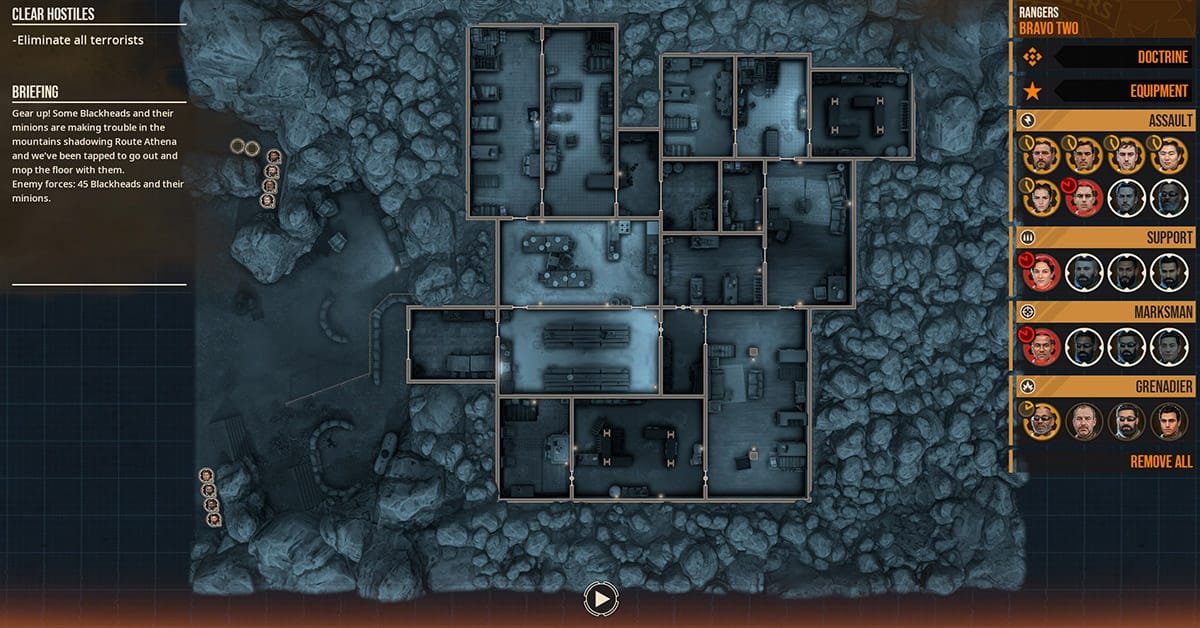
This is the kind of game that fits the “easy to learn, hard to master” saying. Aside from some basic tips, KillHouse Games doesn’t hold your hand. You’re briefly shown how to control your team’s movement and line of sight, how to throw grenades, and how to breach doors; that’s pretty much it.
Luckily, those are the essential actions that will get you through most of the early missions. The missions are gradually built up, and I was able to tackle quite a few before having to dive into the deeper waters of upgrading weapons, ammo, and gear. But more on that later, as I’m also gradually building up this review.
Back to the basics: every mission or campaign begins with positioning your team. Depending on the level, you’ll be given a set of positions to fill. Sometimes you can tackle the challenge with a large team, and other times you have to work with a duo (though you can always choose to deploy fewer agents if you prefer a more stealthy infiltration).
You have several options for positioning your team. For example, you can have them start from the same side or spread them out to ambush enemies from different angles. This is always a decision you must make carefully. Enemies remain hidden as long as they are not visible to your team, so if you’re not strategic, it’s easy to enter a room with just one or two soldiers and be greeted by a group of five terrorists.
Additionally, this prep phase lets you pick certain roles. Over the course of the game, you unlock multiple squads, but you begin with the Ranger squad. This squad consists of Assault, Support, Marksman, and Grenadier specialties. The right mix can turn a failed mission into a successful one.
Each group has its own specialty. Assaulters wield rifles and excel at clearing rooms. Support gunners can suppress enemies with sustained fire. Marksmen are extremely effective at long range, while Grenadiers are there for heavy artillery. Within these groups, every soldier has their own skills that affect how fast they aim, how accurately they shoot, and how well they handle gear like explosives and lockpicks.
Movement Paths, Line of Sight, and Instructions
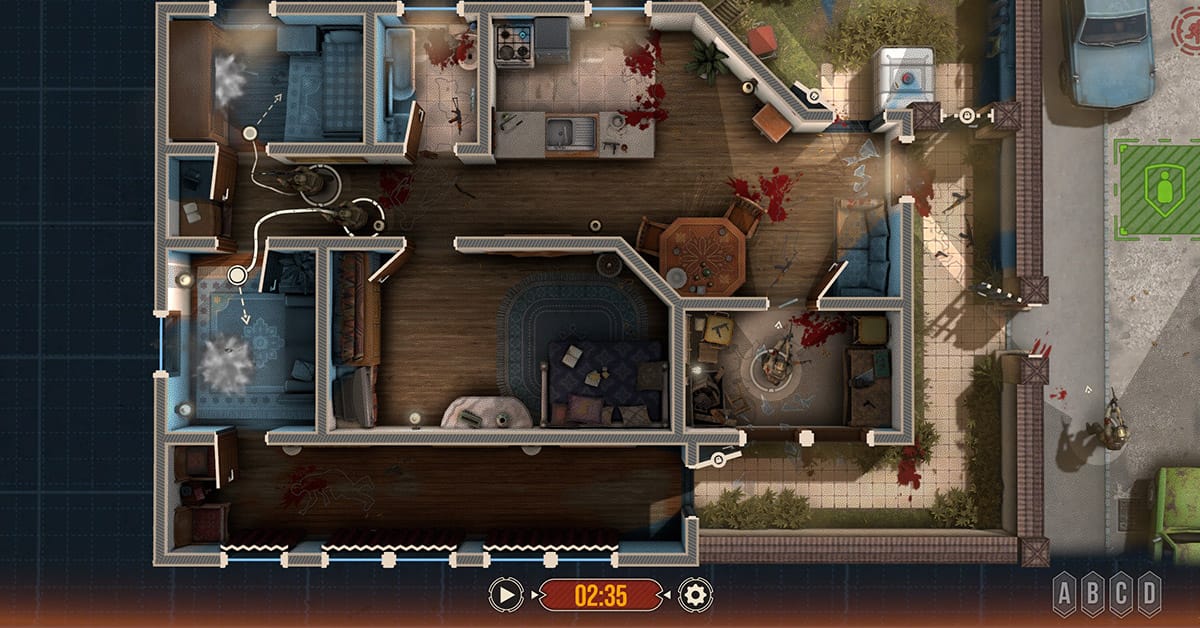
Once the prep phase is complete, the real infiltration can begin. You can select individual soldiers and determine the route they should take. By clicking and holding the mouse button, you can draw the path you want them to follow. It’s incredibly simple, yet so effective.
The ability to draw movement paths with your mouse gives you a lot of control, and for some strange reason, it was always satisfying to resume the game and watch my route being followed to the letter. The only downside is that you have to manage each agent separately. You can’t group multiple soldiers together or send them in the same direction at the same time; it’s always one by one.
As you map out the route, you can right-click at any point along the path to draw another line that determines where the soldier will look. At the start of a level, most rooms are ‘dark,’ as they are still unknown. When you direct a soldier to look in a specific direction, the area lights up, allowing them to spot enemies. Once an enemy is in the line of sight of one of your agents, your soldier will automatically open fire (unless you issue different instructions).
“It feels incredibly satisfying to unpause the game and see your commands executed exactly as you envisioned.“
By combining movement paths and line of sight, you can, for example, have a unit walk past a doorway and, as they step into the opening, quickly peek inside. Or you can have two agents enter an unknown room at the same time, one looking to the left and the other to the right. It feels incredibly satisfying to unpause the game and see your commands executed exactly as you envisioned.
Another thing that gave me immense satisfaction, once again something fundamental, was the thrill of posting one agent by a closed door, having a second agent kick the door open from cover, and then watching as the first agent takes full advantage of the surprise effect to eliminate the terrorists inside. While this may be the absolute basics of Door Kickers 2: Task Force North, executing such actions made me feel like a top-tier general every time.
Upgrading your Equipment
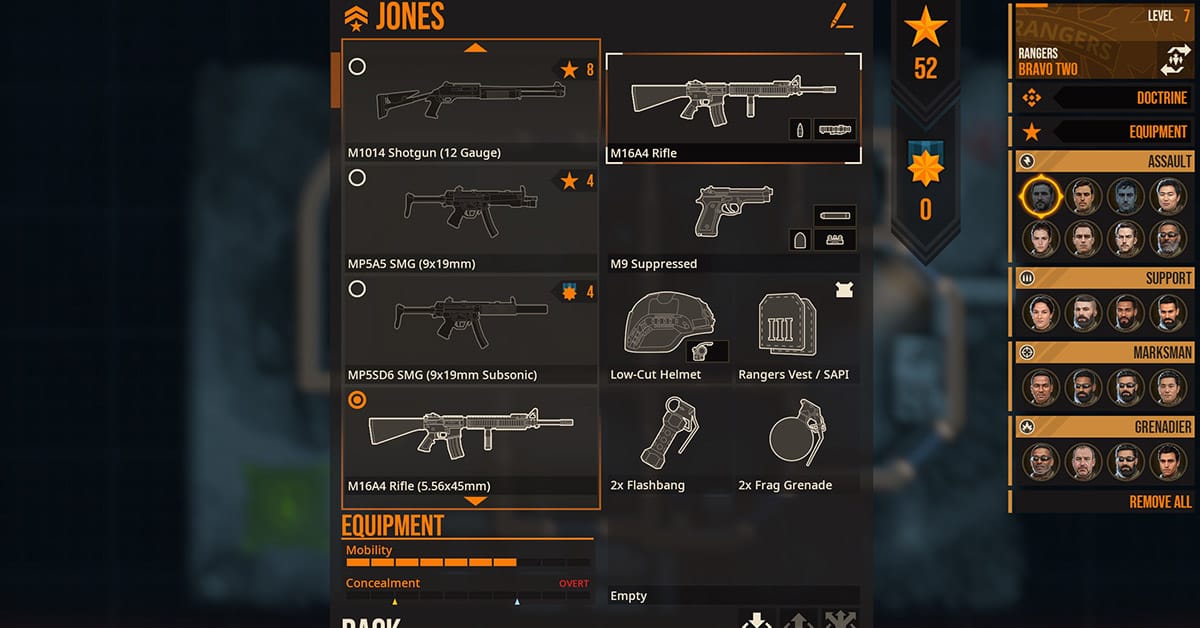
With my simple tactics, I didn’t always get away unscathed. Over time, you’ll face more and more terrorists, who are not only better positioned but also better equipped. The first time I saw a rocket fired at my team, I didn’t know how quickly I needed to pull back. And suicide bombers can also really catch you off guard if you’re not paying attention.
In such cases, you’ll do well to dive deeper into your options, with one of the most important being upgrading your team’s equipment.
By successfully completing missions, you earn stars. A flawless infiltration with no casualties will earn you 3 stars, while completing a mission with high casualties may result in just 1 star at worst. These stars can be used to unlock new equipment.
First off, you can unlock new primary and secondary weapons. For example, you can swap the M16A4 rifle for a 12 Gauge shotgun or an M4 carbine. But that’s not all—you can also change your ammo type or unlock a suppressor, which will make your stealth operations much easier.
Your helmets and bulletproof vests can also receive upgrades. Many options come with both pros and cons. For instance, if you opt for a bulletproof vest offering more protection on the front and back, you’ll sacrifice protection on the sides. The same goes for weapons: some may be faster to aim, but the damage or critical hit chance may be lower.
You can also choose to unlock night vision or tools that help you breach closed doors or fences. Maybe you’d rather blow a door open with a shotgun. Or, while we’re on the topic of aggressive approaches, you might prefer to demolish an entire wall with a wall breacher. If you go this route, however, make sure there’s no hostage in the next room, as collateral damage is always a risk.
Every Situation Requires a Different Approach
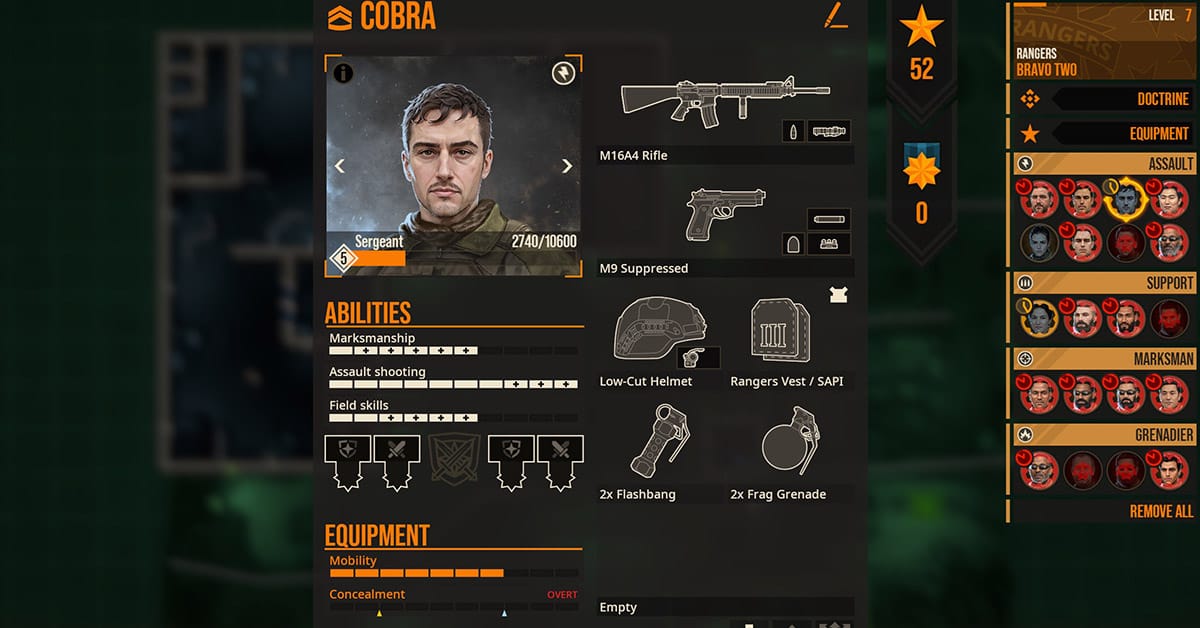
These pros and cons ensure that you can’t simply upgrade your gear and carry on as usual. Depending on the challenge your team is facing, you’ll need to adapt your loadout. If you need to keep hostages alive, you’ll have to be more careful and restrained to avoid accidentally taking out the very people you’re trying to save. But if your mission is to clear a building of terrorists, you can unleash heavy firepower without worry.
If a level features many tight spaces and blind corners, you’ll want to rely on soldiers with high mobility who excel in close-quarters combat. On the other hand, if the environment consists of long, open areas, marksmen will be your best allies.
This is largely a positive aspect, as it prevents you from getting complacent and keeps your tactical thinking sharp. However, it can sometimes become a bit tedious to adjust your loadout for every single mission. With the sheer number of available options, all that switching around can start to feel like a chore over time.
“Even though agents are just avatars with a set of skills and no personality, I found myself growing attached to certain ones. Every time Cobra took down an enemy flawlessly from long range, I couldn’t help but think: ‘My man..’.”
A great solution would be the ability to save weapon loadouts under specific names. I would have loved to create presets like ‘Long Range’ or ‘Stealth’—it would have saved a lot of time and eliminated minor frustrations.
Beyond loadouts, there are other mechanics that can give you a strategic advantage. One that stands out is the use of Gocodes. With four codes, A, B, C, and D, you can synchronize your team’s actions with precise timing.
For example, you can have two soldiers throw a flashbang and link this action to Gocode A, while assigning two others to storm the room as soon as the flashbang goes off, linking that action to Gocode B. Your planned sequence will begin as soon as you click the corresponding code at the bottom of the screen. You’ll hear ‘yourself’ say “Alpha, go” or “Bravo, go,” and your team moves in to execute your plan. It’s all just pretty badass and it feels great to take down enemies in such a well-coordinated way.
Of course, you could also just throw a flashbang, pause the game, and then manually order the second unit to storm the room. In many cases, it’s up to you how challenging you make it for yourself. But I imagine that the more time you spend playing Door Kickers 2, the more creative, tactical, and lethal you’ll become.
Both Your Team and Soldiers Level Up
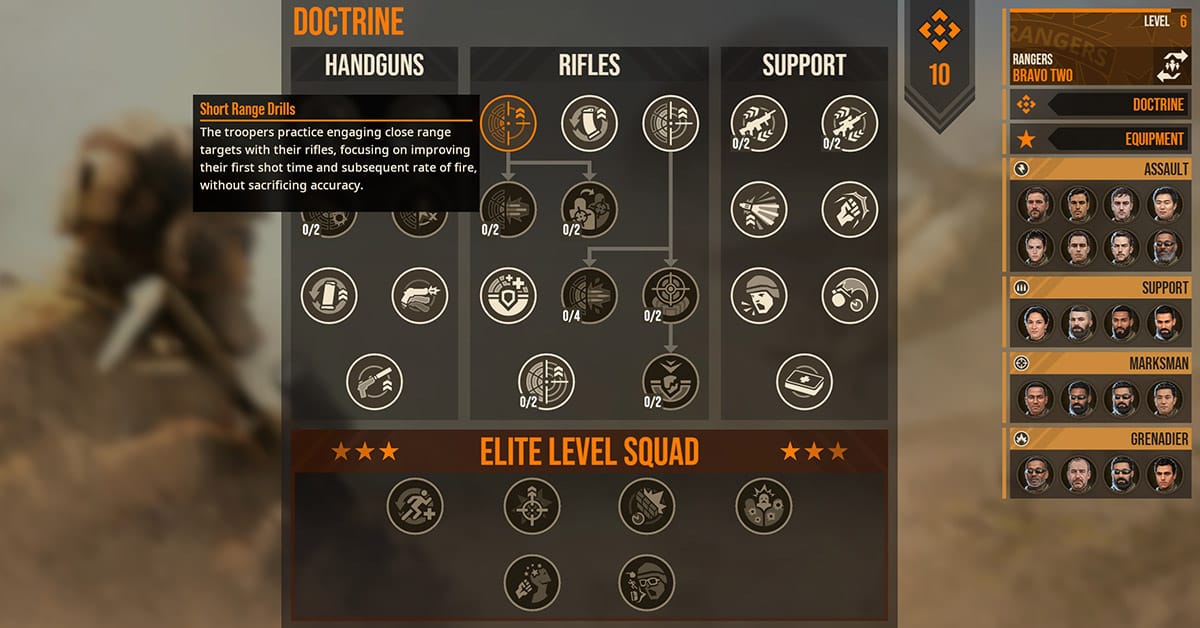
After successful missions, your soldiers earn new ranks, enhancing their skills in noticeable ways.
Even though agents are just avatars with a set of skills and no personality, I found myself growing attached to certain ones. Every time Cobra took down an enemy flawlessly from long range, I couldn’t help but think: “My man..”. This kind of made me wish that the campaigns had a little more narrative depth. Even some small interactions between team members would’ve gone a long way in making the experience feel more alive on that front.
At the end of each mission, your team members gain XP based on their performance. The mission summary provides interesting insights, displaying stats such as distance traveled, shots fired, kills, and even how many bullets they took. Those who consistently delivered top results quickly earned my trust, and a permanent spot in my starting lineup.
Your entire team also gains experience as a unit, earning Doctrine Points. These can be spent on unlocking perks, like faster reload speeds, the ability to self-heal, or improved effectiveness at certain distances.
Another in-game currency for upgrading your team are Battle Honors, awarded for completing full campaigns. Campaigns consist of multiple missions and diverse scenarios. Unlike standalone missions, campaigns introduce continuity; injured soldiers will be unavailable for upcoming missions, and those who are Killed in Action won’t return for the rest of the campaign. R.I.P., my beloved Cobra.
Conclusion

Doorkickers 2: Task Force North is an incredibly engaging and addictive tactical top-down strategy game in which fans can easily sink hundreds of hours without ever getting bored.
Planning and executing successful infiltrations is immensely rewarding. Failed operations are rarely frustrating, and instead, motivate you to be better prepared for the next attempt.
Minor frustrations, such as the loadout system and the lack of ability to group soldiers, are small blemishes on an otherwise excellent game that genre enthusiasts are sure to enjoy.

